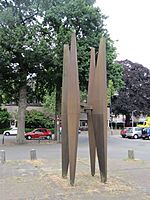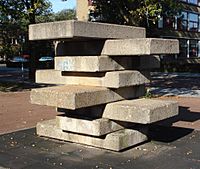Carel Visser facts for kids
Carel Nicolaas Visser (born May 3, 1928 – died March 1, 2015) was a famous Dutch artist who made sculptures. He is known for his unique style called abstract-minimalist constructivism. This means his art often used simple shapes and industrial materials.
About Carel Visser's Life
Carel Visser was born on May 3, 1928, in a town called Papendrecht in the Netherlands. He started his studies in architecture at the Technical University in Delft from 1948 to 1949. After that, he decided to study sculpture. He went to the Royal Academy of Arts in The Hague from 1949 to 1951.
Becoming an Artist
After finishing his studies, Carel Visser also spent some time learning in England and France. In 1952, he became an independent artist and moved to Amsterdam.
When he first started his career, Visser made interesting sculptures of birds out of iron. His very first art show where only his work was displayed happened in 1954. It was at a place called Galerie Martinet in Amsterdam.
His Art Style Changes
Around 1957, Carel Visser's art style started to become more abstract. This means his sculptures became less like real objects and more about shapes and ideas. During this time, he traveled a lot. He went to Italy in 1957 on a special scholarship. In 1962, he was a visiting professor at Washington University in St. Louis, USA. He also took a study trip to Mexico in 1965. From 1958 to 1962, Visser also taught art at the Royal Academy in The Hague.
Awards and Recognition
Carel Visser's art became very well-known. In 1968, his work was shown at a big art event called Documenta 4 in Kassel, Germany. In the same year, he represented the Netherlands at the Venice Biennale, which is another very important art exhibition. There, he won the David E. Bright sculpture prize. A film about his art was also made in 1968.
In 1981, Visser moved to Rijswijk. He was a professor at the Ateliers '63 in Haarlem from 1966 to 1998, teaching other artists. He received the Dr A. H. Heineken Prize for Art in 1992. In 2004, he was given the Wilhelmina-ring award for all his amazing work throughout his life.
Carel Visser passed away on March 1, 2015, in Le Fousseret, France. He was 86 years old.
Understanding Carel Visser's Art
Carel Visser is considered one of the most important sculptors in the Netherlands. He is known for his "constructivist" style. This means he built his sculptures by putting different parts together.
Using Everyday Materials
In his later work, Visser often used many different kinds of materials. These included things like old tires, oil drums, car windows, leather, sheepskin, and even eggs. He would carefully arrange these items, which he called objets trouvés (found objects), to create new artworks. Sometimes, his sculptures were compared to music because they used repetition and variations of shapes and materials.
Nature's Influence
Around 1960, Visser focused on making large, solid iron cubes and also "slack" cubes made of wire. Carel Visser was often inspired by nature, like plants and animals. This is why he also used natural materials in his art. Some of these included wood, wool, sand, feathers, bones, rope, and leather.
Art as Environments
Some of his works from 1975 to 1985 were so large and immersive that they could be called environments. This is different from his earlier, more traditional sculptures, like his piece called "The Dying Horse" from around 1949.
Gallery
1950s Artworks
1960s Artworks
1970s Artworks
1980s Artworks
1990s Artworks
Art from the New Millennium
See also
 In Spanish: Carel Visser para niños
In Spanish: Carel Visser para niños
























